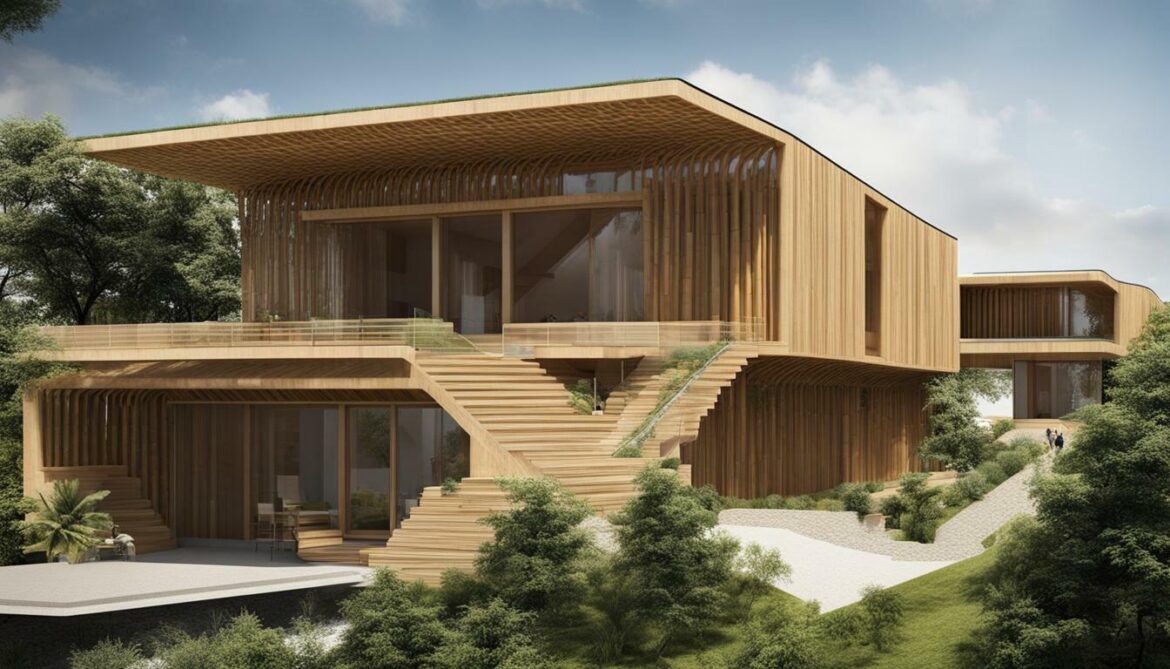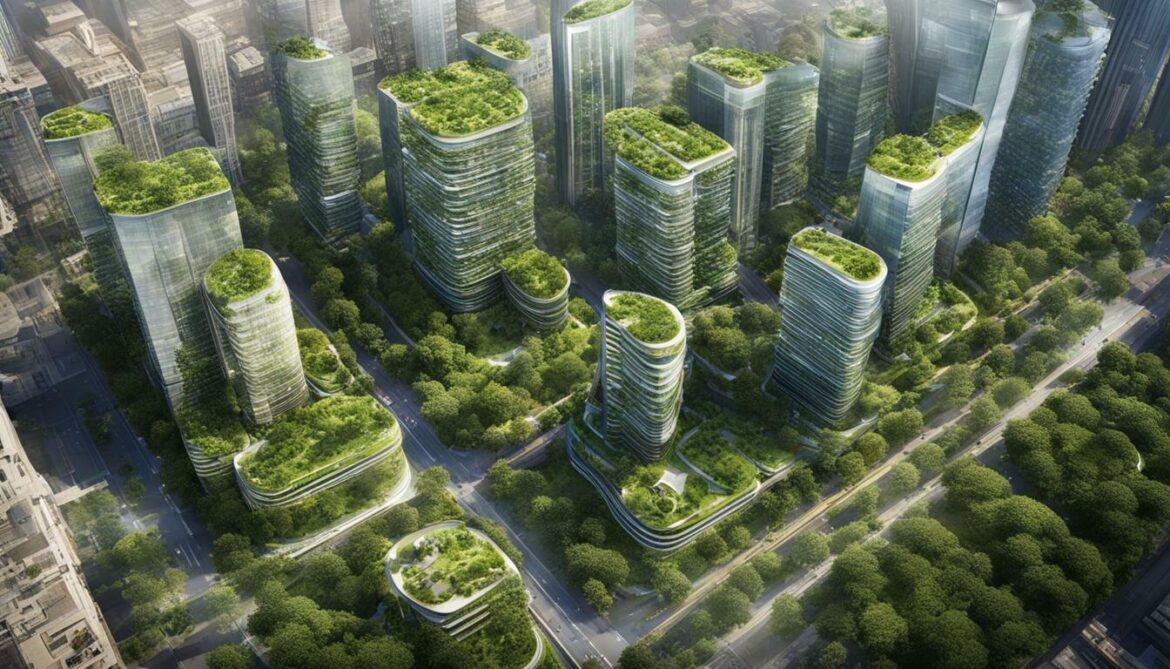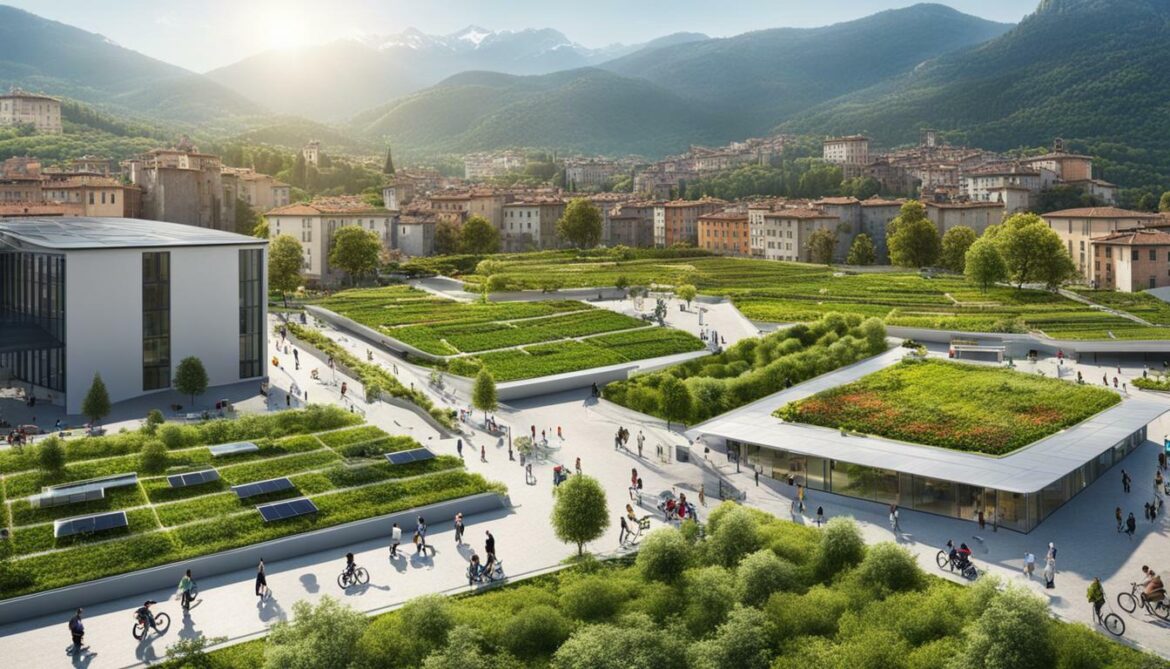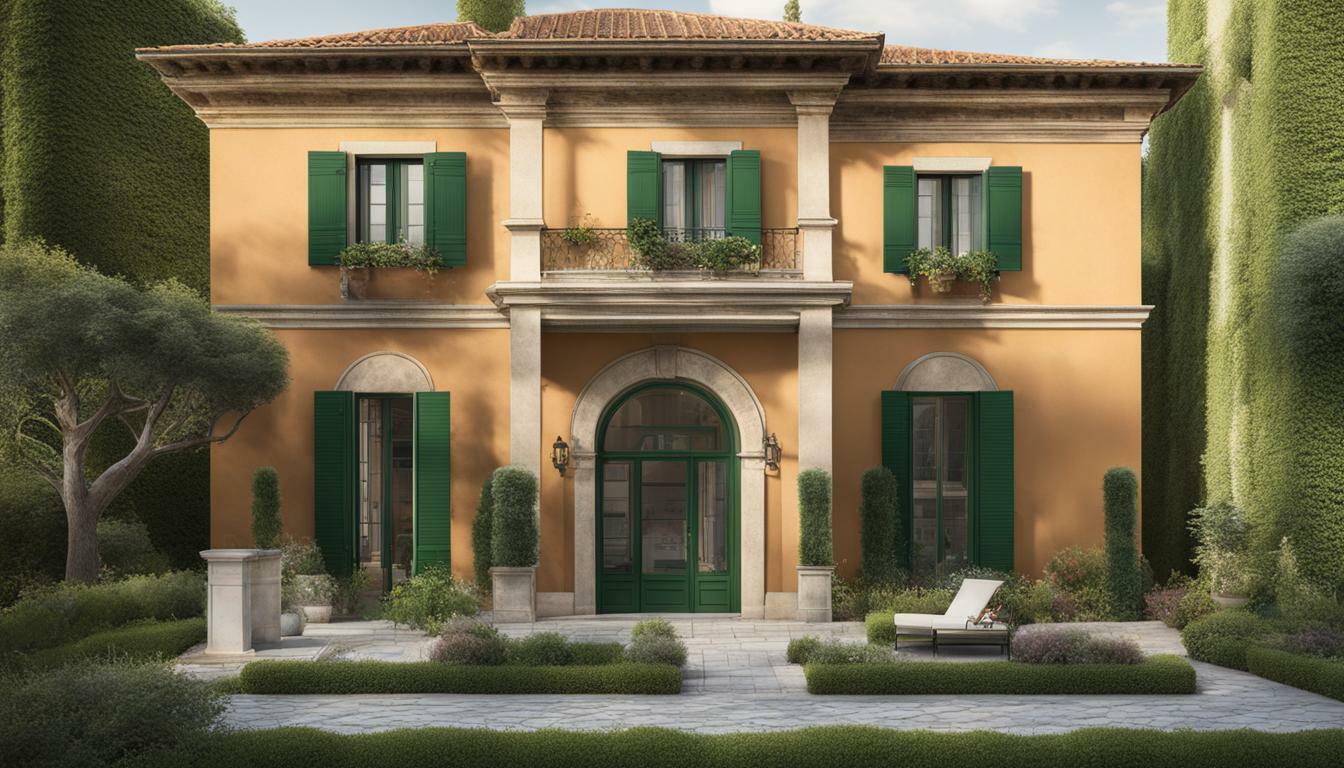Italy has a strong history in green building, with a focus on sustainable architecture and eco-friendly construction practices. The country is known for its commitment to sustainability and has made significant progress in promoting green building initiatives.
The Green Building Council Italia (GBC Italia) was founded in 2008 to further promote sustainable design and construction practices in Italy. GBC Italia has developed certification systems, including a specific rating system for the certification of historical buildings. This ensures that even Italy’s architectural heritage is preserved while embracing sustainable building practices.
Key Takeaways:
- Italy has a strong history in green building, with a focus on sustainable architecture and eco-friendly construction practices.
- The Green Building Council Italia (GBC Italia) plays a vital role in promoting sustainable design and construction in the country.
- Italy ranks eighth in the world for LEED certification, showing its commitment to sustainable building practices.
- The development of vertical green cities, like the Cancun Smart Forest City, is an exciting trend in Italy’s green building movement.
- The COVID-19 pandemic has increased the desire for green spaces and the benefits of incorporating plants into the living environment.
- Italy’s rich history and promising future in green building make it an influential player in the industry.
The Green Building Council Italia (GBC Italia)
Founded in 2008, the Green Building Council Italia (GBC Italia) plays a crucial role in driving sustainable building practices in Italy, promoting the use of eco-friendly construction materials and spearheading green building initiatives. GBC Italia has developed certification systems to encourage the adoption of sustainable design and construction practices across the country. One notable certification system is specifically tailored for the certification of historical buildings, ensuring that Italy’s architectural heritage is preserved while embracing sustainable principles.
Italy has made significant progress in LEED certification, ranking eighth in the world for LEED projects in 2021. This achievement reflects the country’s commitment to sustainability and green building. The demand for certified LEED green buildings is growing in Italy, as more individuals and organizations recognize the benefits of eco-friendly construction.
As a next step in Italy’s green building movement, the development of vertical green cities has emerged as an innovative solution. Projects like the Cancun Smart Forest City in Mexico showcase the potential of these urban environments, combining sustainable building practices with nature-centric design. The integration of green spaces and eco-friendly features in cities not only enhances their aesthetic appeal but also improves the overall well-being of the residents.
The COVID-19 pandemic has further emphasized the importance of green spaces in cities and homes. The desire for nature-filled environments has grown, as studies show that exposure to plants can increase focus, reduce stress, and improve air quality. Incorporating green elements into the living environment has become a priority, driving the adoption of sustainable building materials and practices in Italy.

References:
- Green Building Council Italia. Retrieved from https://www.gbcitalia.org/
- “LEED in Motion: Italy.” U.S. Green Building Council. Retrieved from https://www.usgbc.org/sites/default/files/LEED%20in%20Motion%20Italy.pdf
- “COVID-19 and Green Building: The Impact and Opportunities.” U.S. Green Building Council. Retrieved from https://www.usgbc.org/articles/covid-19-and-green-building-impact-and-opportunities
LEED Certification and Italy’s Ranking
Italy has made significant strides in LEED certification, ranking eighth in the world for LEED projects in 2021, showcasing its commitment to sustainable building practices. The country has also developed a specific rating system for the certification of historical green buildings. This highlights Italy’s dedication to preserving its architectural heritage while promoting environmentally friendly construction.
Italy’s ranking in LEED certification reflects its continuous effort to adopt sustainable building practices. The certification of historical green buildings further emphasizes the country’s commitment to preserving its cultural and environmental legacy. By integrating modern sustainability standards into historical architecture, Italy is setting an example for sustainable preservation worldwide.
The LEED certification system, developed by the Green Building Council Italia (GBC Italia), has played a vital role in promoting sustainable design and construction practices in Italy. GBC Italia’s commitment to sustainable building materials and initiatives has contributed to Italy’s success in LEED certification. By encouraging the use of eco-friendly materials and promoting energy-efficient design, GBC Italia has paved the way for a greener future in Italian construction.
Italy’s focus on LEED certification and sustainable building practices has not only led to environmental benefits but also economic advantages. With the growing demand for certified green buildings in the country, Italy is attracting investors and developers who prioritize sustainability. The integration of sustainable design principles in construction projects enhances their long-term value and contributes to a healthier and more resilient built environment.
| Year |
Number of LEED Projects in Italy |
Italy’s Global Ranking |
| 2017 |
485 |
8th |
| 2018 |
520 |
8th |
| 2019 |
598 |
8th |
| 2020 |
651 |
8th |
| 2021 |
717 |
8th |
Italy’s consistent ranking in LEED certification demonstrates its ongoing commitment to sustainable building practices and its recognition of the environmental and societal benefits they bring. With the development of innovative green building projects and a continued focus on sustainability, Italy is paving the way for a greener, more environmentally conscious future.
The Rise of Vertical Green Cities
The next frontier for Italy’s green building movement lies in the development of vertical green cities, which integrate sustainable building practices into high-rise structures. These innovative urban designs aim to create eco-friendly living spaces that prioritize environmental sustainability. Vertical green cities combine modern architectural advancements with green technologies to maximize energy efficiency, reduce carbon emissions, and enhance the quality of life for residents.
One notable example of a vertical green city is the Cancun Smart Forest City in Mexico. With its vertical gardens, renewable energy sources, and efficient waste management systems, this city is a prime example of sustainable urban development. As Italy looks towards the future, there is a growing interest in adopting similar concepts to create greener and more sustainable cities.
Vertical green cities not only provide solutions for overpopulation and limited land availability but also offer numerous benefits for the environment and the community. They create green spaces within urban areas, improving air quality, reducing urban heat islands, and promoting biodiversity. In these cities, residents can enjoy access to nature, recreational areas, and green infrastructure, all within a compact and sustainable urban environment. The integration of sustainable building practices in vertical green cities is essential for Italy to achieve its sustainability goals and create a greener future.

| Benefits of Vertical Green Cities |
| Improved air quality |
| Reduced urban heat islands |
| Promotion of biodiversity |
| Enhanced quality of life for residents |
| Optimized energy efficiency |
| Sustainable waste management systems |
Quotes:
“Vertical green cities combine architectural innovation with sustainable design principles, creating urban environments that prioritize the well-being of both residents and the planet.”
“The development of vertical green cities is a crucial step towards achieving Italy’s sustainability goals and creating a greener future for generations to come.”
The Impact of COVID-19
The COVID-19 pandemic has heightened the importance of green spaces in cities and homes, leading to a greater emphasis on incorporating sustainable design elements and nature-friendly features that promote well-being. As people spent more time indoors during lockdowns, there was a growing recognition of the positive impact that green spaces and plants have on mental and physical health.
Research has shown that exposure to greenery and nature has a soothing effect on the mind and can help reduce stress levels. Incorporating plants into our living environments not only adds aesthetic appeal but also improves air quality by absorbing pollutants and releasing oxygen. The presence of green spaces, whether in the form of urban parks, rooftop gardens, or indoor plant displays, has become a priority for many individuals and communities.
“The presence of green spaces, whether in the form of urban parks, rooftop gardens, or indoor plant displays, has become a priority for many individuals and communities.”
The benefits of plants within the living environment extend beyond their visual beauty. Studies have shown that being surrounded by greenery can enhance cognitive function, boost mood, and improve overall well-being. In a time when stress levels are high and mental health is a growing concern, incorporating nature-friendly features into our homes and cities is crucial for creating healthy and sustainable living spaces.
| Benefits of Green Spaces |
Benefits of Plants in the Living Environment |
| Improved mental health and well-being |
Better air quality |
| Reduced stress levels |
Enhanced cognitive function |
| Increased physical activity |
Boosted mood |
| Community bonding and social interaction |
Promoted overall well-being |
Image:

As we navigate the challenges and uncertainties brought about by the COVID-19 pandemic, the importance of green spaces and nature-friendly design features cannot be understated. Incorporating sustainable elements into our built environment not only enhances the quality of our lives but also contributes to a greener and more ecologically balanced future. By prioritizing the integration of green spaces and plants into our cities and homes, we can create healthier and more resilient communities that promote well-being for all.
Italy’s Promising Future in Green Building
Italy’s dedication to sustainability and green building practices has positioned the country as a leader in eco-friendly transformation, with a promising future in sustainable architecture and design. With a rich history in green building and a strong commitment to sustainable practices, Italy has made significant strides in promoting environmental consciousness.
The Green Building Council Italia (GBC Italia) has played a crucial role in spearheading sustainable design and construction practices in the country. Founded in 2008, GBC Italia has developed certification systems and initiatives that promote the use of sustainable building materials and encourage the adoption of eco-friendly construction practices.
Italy’s progress in LEED certification is noteworthy, ranking eighth in the world for LEED projects in 2021. The country has also prioritized the certification of historical buildings, recognizing the importance of preserving green architectural heritage. This commitment to sustainability has led to a growing demand for certified LEED green buildings in Italy.

The next frontier in Italy’s green building movement is the development of vertical green cities. These innovative urban environments prioritize sustainable living through the integration of green spaces, renewable energy sources, and eco-friendly building practices. Notable examples, such as the Cancun Smart Forest City in Mexico, inspire Italy to explore similar initiatives that promote a greener and more sustainable future.
The COVID-19 pandemic has underscored the importance of green spaces in cities and homes. The desire for nature-filled environments has grown, as studies show that being surrounded by plants can enhance concentration and reduce stress levels. Italy recognizes these benefits and aims to incorporate more green spaces and plant life into its urban landscapes.
Italy’s commitment to sustainability in Italy is evident in its dedication to green building and eco-friendly practices. By promoting sustainable architecture and design, the country is actively working towards a greener future. With the ongoing efforts of organizations like GBC Italia and the growing interest in vertical green cities, Italy is set to make significant strides in eco-friendly transformation.
Conclusion
Italy’s green building history showcases its commitment to sustainable architecture and construction practices, with the Green Building Council Italia playing a pivotal role in promoting eco-friendly initiatives. Founded in 2008, the council has been instrumental in developing certification systems and encouraging the use of sustainable building materials in Italy. It has also introduced a specific rating system for the certification of historical buildings, preserving the country’s rich architectural heritage while embracing green principles.
Italy has achieved significant progress in LEED certification, ranking eighth in the world for LEED projects in 2021. This demonstrates the country’s dedication to sustainability and its desire to create a greener built environment. The demand for certified LEED green buildings in Italy continues to grow as more individuals and organizations recognize the importance of environmentally conscious design and construction.
The next frontier for Italy’s green building movement lies in the development of vertical green cities. Examples like the Cancun Smart Forest City in Mexico showcase the potential impact of these innovative concepts on sustainable building practices. Vertical green cities provide an opportunity to maximize land efficiency, reduce energy consumption, and create healthier living environments for residents.
The COVID-19 pandemic has further emphasized the importance of green spaces in cities and homes. The desire for natural environments and the benefits of incorporating plants into the living environment have become increasingly evident. Research suggests that exposure to green spaces can improve focus, lower stress response, and enhance overall well-being.
With its strong history and ongoing commitment to sustainability, Italy is poised for a promising future in green building. The country’s advancements in eco-friendly construction practices, along with the promotion of environmental design, contribute to a brighter and more sustainable future for Italy and its residents.
FAQ
What is the Green Building Council Italia (GBC Italia)?
The Green Building Council Italia (GBC Italia) is an organization founded in 2008 with the aim of promoting sustainable design and construction practices in Italy.
What certification systems has GBC Italia developed?
GBC Italia has developed various certification systems, including a specific rating system for the certification of historical buildings.
How does Italy rank in LEED certification?
Italy ranks eighth in the world for LEED projects in 2021, highlighting its significant progress in sustainable building practices.
What are vertical green cities?
Vertical green cities are emerging urban developments that prioritize sustainability and incorporate green spaces and eco-friendly building practices.
What is the impact of COVID-19 on green building in Italy?
The COVID-19 pandemic has increased the desire for green spaces in cities and homes, highlighting the importance of incorporating plants into the living environment.
What is the future of green building in Italy?
Italy has a promising future in green building, with a rich history in sustainable construction practices and a strong commitment to sustainability.
Source Links






















Post comments (0)